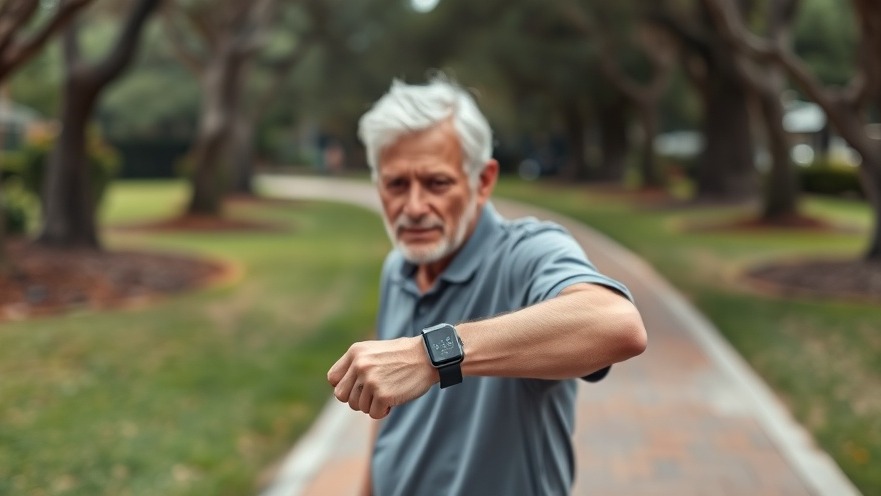
Connecting Generations: The Power of Technology for Seniors
Imagine a world where age doesn’t limit connections, where every senior can easily reach out to family and friends, and where help is just a button away. That’s not just a dream; it’s the reality being shaped by technology today! In our fast-changing world, technological advancements have become essential tools for enhancing the lives of our elderly population.
Bridging the Gap
Many seniors face challenges like isolation and difficulties accessing essential services. Fortunately, organizations like Seniors First are at the forefront of using innovative technology to bridge this gap. By implementing creative solutions, they tackle the loneliness that often comes with aging and ensure that seniors are not only safe but also connected to their loved ones and communities.
Innovative Strides for a Brighter Future
With the help of Seniors First, technology is no longer reserved for the younger generations. Through various programs and tools, seniors are learning how to navigate smartphones, tablets, and computers with confidence. Simple video calls can now replace long silences, bringing families closer together, even if they are miles apart. This article will explore how Seniors First is harnessing technology to spice up the golden years for many and create a brighter, more connected future.
How Seniors First Bridges the Digital Divide with Engaging Activities for Seniors
The picture of a tech-savvy senior is no longer an anomaly but increasingly becoming the norm, thanks to the groundbreaking initiatives undertaken by Seniors First. By introducing engaging and interactive activities designed specifically for older adults, this organization empowers seniors to embrace technology as an essential part of their daily lives. These activities not only help reduce feelings of isolation but also foster a sense of community among participants.
The Power of Interactive Learning
Seniors First has secured a treasure trove of engaging programs such as virtual classes, tech tutorials, and gaming sessions that turn learning into a fun experience. From mastering social media to comprehending online shopping, each activity catalyzes the newfound enthusiasm for technology among seniors.
For many seniors, engaging in these activities is a lifeline that promotes mental well-being. The camaraderie established during group classes and online meet-ups fosters friendships that transcend digital boundaries. With empathy at its core, Seniors First recognizes that learning doesn’t stop at technology; it extends to creating lasting connections. Whether it’s through crafting a family photo album online or learning how to stream a favorite movie, every small achievement contributes significantly to a senior’s self-esteem and happiness.

Creating a Safe Space
Another critical component in bridging the digital divide is establishing a safe and encouraging environment for seniors to explore technology without intimidation. By incorporating supportive peer networks and knowledgeable facilitators, Seniors First creates an atmosphere where seniors feel comfortable asking questions and making mistakes—a crucial aspect of the learning process. This nurturing atmosphere transforms technology from a daunting challenge into an accessible tool that enriches lives.
As we reflect on the impressive strides taken by Seniors First, it becomes evident that the organization stands as a beacon of hope, illuminating paths for seniors to navigate the complexities of the digital age. Their multifaceted approach not only addresses the immediate needs of connectedness but also lays the groundwork for a future where technology serves as a bridge rather than a barrier for older adults.
Social Media's Positive and Negative Impacts on Senior Well-Being
To gain deeper insight into how technology influences senior well-being, we had the opportunity to sit down with Marsha Lorenz, the visionary CEO of Seniors First. With her extensive experience in advocating for senior interests, Marsha sheds light on the complex interplay between social media and aging populations.
"Social media is a double-edged sword," Marsha explains. "While it offers seniors a connection to family and friends, it can also amplify feelings of loneliness if not used mindfully." This perspective is especially significant as we explore how platforms like Facebook, Instagram, and Zoom can either uplift or isolate the very individuals they are meant to connect.
The Bright Side: Fostering Connections
Marsha highlights the myriad benefits social media can provide to seniors. "When used positively, social media can break down geographical barriers, allowing seniors to maintain relationships and engage in communities across the globe," she says. The ability to share updates, photos, and important life events fosters a sense of belonging that many older adults crave. Virtual gatherings and social media channels serve as lifelines, enhancing emotional health and creating vibrant online communities where seniors can support one another.
However, as family and friends increasingly turn to these platforms to communicate, seniors who lack digital literacy can feel left out. Consequently, it becomes vital for organizations like Seniors First to provide the necessary training, ensuring seniors can navigate these spaces confidently.
The Downsides: Navigating a Complex Terrain
Despite the advantages, Marsha cautions against the pitfalls of social media use among seniors. Negative sentiments, misinformation, and online bullying can unearth feelings of inadequacy or fear of missing out. "We must educate seniors about the potential hazards of social media, including privacy concerns and harmful content," Marsha emphasizes. The challenge lies in fostering a balanced perspective that embraces the positives while acknowledging potential dangers.

Through programs aimed at harnessing the positive aspects of social media, such as moderated online discussions, Seniors First empowers seniors to become proactive participants in the digital age rather than passive consumers. This means arming them with the skills to report negative experiences or disengage from harmful interactions, ensuring their online presence remains beneficial.
As we delve deeper into the role of technology in combating senior isolation, Marsha Lorenz's insights remind us that while social media can be a source of enrichment, it requires a thoughtful approach to maximize its benefits. By fostering digital literacy and creating supportive networks, we can shape a future where seniors thrive amidst the digital landscape, enjoying the richness of human connection it has to offer.
The Rise of Wearable Technology: Enhancing Safety and Health Monitoring for Seniors
As we transition from the realm of social media, another technological advancement is making waves in the lives of seniors—wearable technology. From smartwatches to fitness trackers, these devices are not only innovative but are becoming essential tools for enhancing senior health and safety. Marsha Lorenz points out, “Wearable technology has the power to revolutionize how we care for our aging population. It acts as a bridge connecting them to their caregivers, healthcare providers, and even family members.”
Gone are the days when monitoring health metrics meant frequent trips to the doctor’s office. Today, seniors can track their heart rates, monitor their sleep patterns, and even keep tabs on their physical activity—all from the convenience of their wrist. This immediate access to health data fosters a sense of empowerment, allowing seniors to take charge of their health in ways that were once unimaginable.
Moreover, wearable devices equipped with features like emergency alerts and fall detection systems can be a lifesaver. “These wearables create an added layer of security, providing peace of mind not only to the seniors wearing them but also to their loved ones,” Marsha explains. The ability to send an immediate alert to family members or emergency services in case of a fall can make a significant difference in outcomes during critical moments.
However, as with all technological innovations, embracing wearables does not come without challenges. Seniors may face hurdles such as technical difficulties, discomfort with new technology, or privacy concerns related to data sharing. Marsha stresses the importance of tailored education and support, stating, “For seniors to fully benefit from wearable technology, they need to comprehend both the functionality and the implications of using these devices.”
Initiatives like hands-on workshops and one-on-one tutorials can provide seniors with the skills and confidence necessary to navigate this new landscape. By understanding how to use wearable technology effectively, older adults can not only enhance their safety and health but also increase their overall quality of life.
In conclusion, as we explore the rapidly changing terrain of technology, it is evident that both social media and wearable technology play critical roles in shaping senior well-being. With a balanced approach that fosters education, training, and community support, we can harness the full spectrum of benefits these tools offer, ultimately leading to a more enriched and connected aging experience.
Empowering Independence: The Benefits of Wearable Technology for Seniors
As the popularity of wearable technology continues to soar, so does the potential for seniors to live healthier, more independent lives. These devices not only measure fitness metrics, but they also play a crucial role in managing chronic conditions and promoting preventive health care. With a variety of options available, seniors can select wearables designed specifically for their needs, allowing for customization in care—an essential factor in addressing each individual's unique health journey.
Consider the various functions offered by these devices. Some of the most impressive features of modern wearables include heart rate monitoring, ECG readings, blood oxygen level tracking, and medication reminders. The table below highlights popular wearable devices currently making a difference in senior healthcare:
Device |
Features |
Benefits for Seniors
|
|---|---|---|
Apple Watch Series 7 |
Heart rate monitoring, ECG, fall detection, emergency SOS |
Real-time health alerts; immediate access to emergency services; enhances fall monitoring |
Fitbit Charge 5 |
Heart rate, sleep tracking, stress management, guided breathing |
Tracks overall wellness; promotes better sleep and stress management; fosters physical activity |
Garmin Forerunner 245 |
Heart rate, advanced sleep monitoring, activity tracking |
Encourages competitive spirit through activity goals; aids in maintaining fitness |
Samsung Galaxy Watch 4 |
Body composition measurement, stress and sleep tracking, ECG |
Provides comprehensive health insights; promotes holistic health monitoring |
Such features not only promote better health and awareness but also facilitate early intervention in potential health crises. Research suggests that timely data can aid in discriminating between normal health fluctuations and concerning trends. By alerting healthcare providers just as soon as issues arise, seniors benefit from a proactive rather than reactive approach to health management.
In addition to physical health benefits, wearable technology serves as a pivotal conduit for social connection. Many wearables come equipped with social features—whether it's sharing daily activity progress with family or engaging in fitness challenges with peers. This dual function of promoting health and fostering community integration can significantly combat feelings of loneliness and isolation, a frequent challenge among older adults.
As we pave the way towards integrating wearable technology into senior care, it's critical to acknowledge the collaborative efforts involving families, caregivers, and healthcare professionals. Open dialogues about technology integration can encourage seniors to express their concerns, preferences, and desires, ensuring that the solutions implemented genuinely reflect their needs and enhance their well-being.
In the ever-evolving landscape of healthcare technology, the seamless transition into telemedicine marks a new frontier for seniors. While wearable technology has proven to be a remarkable tool for promoting health and safety, the combination of these devices with telemedicine services can amplify the advantages significantly, fostering a comprehensive care approach that truly empowers seniors to embrace the best years of their lives.

Telemedicine: A New Frontier for Senior Healthcare Access and Support
The intersection of telemedicine and wearable technology is revolutionizing the healthcare landscape for seniors, ushering in an era of unprecedented access and support. With the digital divide narrowing, telehealth platforms are paving the way for seniors to receive timely and efficient medical attention from the comfort of their homes. By transforming traditional healthcare delivery, telemedicine addresses many barriers that older adults face, including mobility issues, transportation challenges, and limited access to specialized care.
Imagine a scenario where a senior experiencing health concerns—be it a sudden spike in blood pressure detected by their wearable device—can connect instantly with their healthcare provider through a video call. This immediate response not only alleviates anxiety but also offers a sense of control over their health. Telemedicine allows for this level of interaction, empowering seniors to manage their health more proactively, rather than waiting for inevitable complications. Through virtual consultations, seniors benefit from quality care while reducing the risk of exposure to illnesses present in crowded waiting rooms.
Moreover, telemedicine enhances continuity of care, a crucial element of effective management for those with chronic conditions. By allowing healthcare professionals to monitor patients remotely, real-time data from wearable devices can inform treatment decisions, ensuring care plans are always tailored to the senior's current health status. This connectivity between wearables and telemedicine creates a dynamic ecosystem where healthcare can adapt to the needs of patients, leading to better health outcomes.
But the benefits of telemedicine extend beyond medical care alone. Many telehealth platforms offer mental health services, which are vital for combating the isolation that often plagues the elderly population. Virtual therapy sessions, support groups, and wellness webinars provide seniors with valuable opportunities to engage with professionals and peers, thus building a supportive network that fosters emotional well-being.
As we explore how technology can enrich senior lives, it becomes apparent that access to these innovative services is essential. Many seniors are not only hesitant to adopt new technologies, but they may also lack the resources and education to use telehealth effectively. This creates an urgent call to action for communities: empower seniors by advocating for greater technological access and support systems.
Volunteering or donating to organizations dedicated to helping older adults, such as Seniors First, can create tangible impacts. These initiatives often provide essential training and resources, ensuring that seniors can comfortably navigate both wearable devices and telemedicine platforms. By bridging the technology gap, we can enhance the quality of life for our senior citizens and ensure that they have the tools they need to enjoy their lives to the fullest.
In conclusion, embracing the combination of wearable technology and telemedicine represents a profound shift in senior healthcare. As we advocate for improved access and support for our older community members, we are not just advancing healthcare—it’s about fostering dignity, independence, and a connectedness that allows seniors to thrive. Let’s rally together to create an ecosystem where technology becomes a bridge to a healthier, happier future for our seniors.
Empowering seniors within our communities is more crucial now than ever, particularly as we navigate an increasingly digital world. While technology holds the promise of connection and support, realizing its full potential hinges on ensuring that our senior citizens have access to the necessary tools and education. By advocating for greater technological access, we can help dismantle the barriers that have long isolated this demographic, allowing them to actively engage in their health, social lives, and wider communities.
Picture a neighborhood where seniors confidently use smartphones to participate in family video chats, sharing joyous moments with grandchildren who live miles away or attending virtual community events that keep them informed and engaged. Unfortunately, the reality in many areas is that seniors struggle with unfamiliar devices and systems, leading to feelings of frustration and helplessness. This challenge, however, presents a unique opportunity for inspired community intervention— one that can yield incredible rewards.
Initiatives like Seniors First are leading the charge by providing targeted programs that focus on teaching technology skills in a supportive environment. Their workshops often include hands-on tutorials, enabling seniors to practice using devices while guided by patient and knowledgeable volunteers. Imagine the empowerment that comes from a senior finally mastering a video call or learning how to navigate social media—transforming their sense of isolation into connection with loved ones and friends.
Community support can extend beyond just educational programming. By becoming involved as a volunteer, you not only impart critical technology skills but also foster companionship. The simple act of checking in on a senior neighbor, helping them set up their device, or just sharing a cup of coffee can make a world of difference. Your presence validates their experiences and relationships, reinforcing the idea that they are not alone on this journey.
Moreover, donations to organizations such as Seniors First allow them to expand their reach and impact. Every contribution can fund essential projects like community tech fairs, where numerous seniors can be exposed to different technologies and resources in a single event. Such initiatives not only teach technical skills but also provide a space for social interaction, thereby countering loneliness and fostering friendships. With adequate funding, programs can also tailor their approaches to accommodate varying levels of technological literacy among seniors, ensuring that no one gets left behind.
Spreading awareness is another pivotal component in supporting technological initiatives for seniors. Many adults might not consider the challenges their elderly family members face in adapting to the digital age. By sharing information about available resources and events in your community, you can encourage friends and neighbors to lend a hand. Awareness of such initiatives encourages a culture of inclusivity, where technology becomes a shared experience, rather than an intimidating barrier.
To summarize, empowering seniors through technology involves a multifaceted approach that encompasses education, volunteerism, donations, and awareness. It’s about creating an environment where our elderly friends and family members can seamlessly integrate technology into their lives, reducing feelings of isolation and enhancing their overall well-being. By coming together as a community, we can harness the power of technology to forge stronger connections, promote independence, and uplift our senior citizens. When we invest in their ability to engage with the world, we’re not just improving their lives—we're enriching our communities as a whole.
Empowering Our Seniors: The Call for Advocacy and Community Support
As we stand on the cusp of a technological renaissance, the benefits for seniors extend far beyond the marvels of telehealth and wearable devices. The real game-changer lies in our collective effort to empower these vital members of our communities by ensuring they have the access and support necessary to fully embrace these advancements. At the heart of this mission is advocacy—raising awareness, breaking down barriers, and fostering environments where seniors feel both encouraged and enabled to engage with technology.
This empowerment journey begins with education. Many older adults are understandably hesitant to integrate new technologies into their lives. This resistance is often rooted in unfamiliarity rather than an unwillingness to learn. Communities can play a pivotal role by organizing workshops and hands-on training sessions that demystify technology. By volunteering your time to lead these initiatives, you can make learning accessible and enjoyable for seniors, transforming uncertainty into confidence.
Moreover, advocating for funding and resources dedicated to tech education for seniors can drive meaningful change. Local governments and organizations often have grants or programs available to support such initiatives; it’s essential that community members band together to ensure these resources are prioritized. Just imagine a community where every senior has access to the training they need—not just to understand telemedicine, but also to leverage the full spectrum of digital tools available at their fingertips.
Organizations like Seniors First are at the forefront of this advocacy. Through their programs, they offer comprehensive support systems designed to equip seniors with the skills and knowledge necessary to navigate today’s technology. By donating to or volunteering with such organizations, individuals can become part of something greater—a collective movement towards inclusivity that empowers seniors to take charge of their health and well-being.
But advocacy doesn’t have to stop at education alone. Community members should actively encourage local institutions—libraries, community centers, and healthcare facilities—to incorporate technology access points specifically for seniors. Whether it’s establishing senior-friendly computer labs or offering free tech help days with local volunteers, the possibilities are endless. Just think of the positive outcomes that ripple out from such efforts: increased digital literacy, higher rates of technology adoption, and ultimately, enhanced health outcomes.
Another critical aspect of this movement is fostering intergenerational connections. Younger community members can step up as mentors, providing one-on-one tech tutoring sessions to seniors. This not only enriches the lives of older adults but also cultivates patience, empathy, and a greater understanding of the shared human experience among all ages. A new generation can learn about the rich histories and experiences of their elders, while simultaneously providing them with essential tools to thrive in a digital world.
As we embark on this crucial mission, it's vital to remember that true empowerment requires ongoing commitment. Regular follow-up sessions, check-ins, and sustained programming can greatly impact seniors' confidence and comfort with technology. Building a foundation of ongoing support ensures that the initial strides taken toward innovation do not wane but instead flourish into a long-lasting culture of tech adoption and engagement.
In closing, the journey toward empowering seniors through technology is both a responsibility and an opportunity. By advocating for greater access and supporting organizations dedicated to their needs, we plant the seeds for a vibrant, engaged, and healthy senior community. Let’s come together, take action, and ensure that our senior citizens are not just passive recipients of technology, but empowered navigators of their own lives, health, and happiness.
 Add Row
Add Row  Add
Add 





 Add Row
Add Row  Add
Add 
Write A Comment